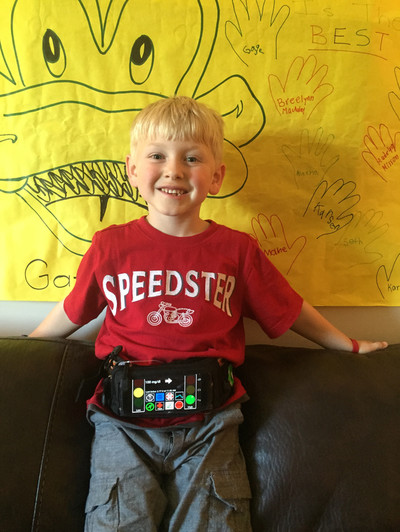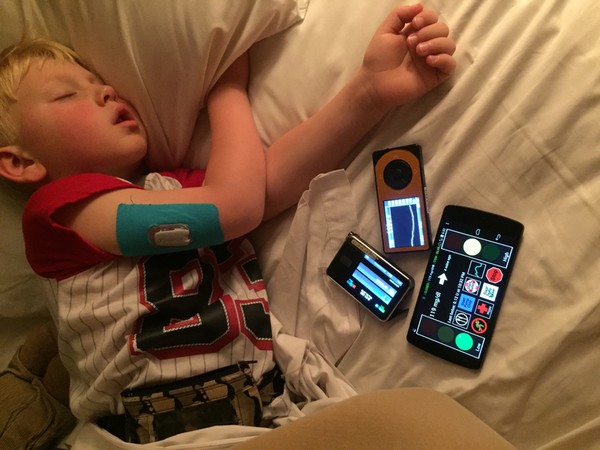The Future Teller
Joshua Davis is your typical second grader. He loves sports and playing with his friends. His favorite subject is math, a class he unfortunately often has to miss. It all depends on his blood sugar levels.
When he was just 11 months old, Joshua was diagnosed with Type 1 diabetes. The discovery didn’t come quickly or easily, his mother Shannon Davis explains.
“All of his symptoms were excusable,” Shannon says. “He was wetting through his diaper, but we switched to a larger size diaper. He had just started walking a few months before that, so he was losing weight. He was cranky, but he was teething.”

Just before Joshua turned one, the Davis family rushed him to the emergency room after he began vomiting and becoming unresponsive. Initially, it was thought that he had the flu, but another physician was called in just to be sure.
The turning point came when this doctor smelled Joshua's breath and realized what all the “excusable” symptoms were really pointing to—a very, very high blood sugar level. The Davis family later learned that, at diagnosis, their son’s blood sugar level was more than 1,200 mg/dl (a normal level for Joshua today is between 100 and 200 mg/dl) and he had been within three hours of passing away. Joshua immediately started treatment at Children’s Hospital of the King’s Daughter in Norfolk, Virginia.
A Day in the Life
Almost eight years later, Joshua has his healthcare routine down. Diabetes requires constant monitoring, so he goes to his school’s clinic several times a day to test his blood sugar levels to make sure they’re stable. If the results come back low, he often has to eat something—even if he’s not hungry—and then wait 15 minutes before he can test again.
Now, a breakthrough technology developed at UVA will help make Joshua’s life more normal. UVA’s Center for Diabetes Technology has spent years developing a smart phone that acts as an artificial pancreas—a device that automatically regulates blood sugar levels through customized algorithms and insulin delivery.
The first time Joshua and his family made the journey to UVA was so that he could participate in one of the artificial pancreas clinical trials. For three days the device kept him stable while he played soccer, rock-climbed, and played in a bounce house—all activities that greatly impact his sugar levels. The entire time, thanks to the artificial pancreas, his levels only dipped low once.
“I never felt icky. I never had a tummy ache. I never had headaches,” Joshua remembers. “And,” his mom adds, “the best part was he never had to interrupt any of his activities. The artificial pancreas thought for him, and was able to keep his insulin levels at the right level.”
“It’s kind of like a future teller,” Joshua explains. “It can tell when you’re about to go high, when you’re about to go low. It can tell what you’re about to be."
Now, UVA researchers are on the cusp of bringing this technology to market, a breakthrough that will provide diabetes patients with a method of treatment that makes their disease more manageable and better controlled. Furthermore, continual use of a stabilizing device like the artificial pancreas may help diabetes patients avoid serious complications—including blindness, blood vessel problems, and heart issues—down the road.
How It Works
UVA Center for Diabetes Technology founding Director Boris Kovatchev, PhD, is the principal investigator behind the JDRF Artificial Pancreas Project at UVA, a multi-center study that also involves Stanford University, UC Santa Barbara, the Universities of Padua (Italy) and Montpellier (France), and the Schneider Children’s Medical Center in Israel.
The artificial pancreas system has four main parts. A CGM (continuous glucose monitor) is placed under the patient’s skin and measures glucose levels throughout the day, transmitting them to a CGM receiver. In turn, the receiver sends these readings to a smartphone, which is “home” to the artificial pancreas. The smartphone then uses an advanced algorithm to personalize insulin dosages depending on a patient’s blood glucose levels. These dosages are broadcasted to an implanted insulin pump, which in turn delivers the correct insulin dose directly through the bloodstream.
“My father had diabetes, so I knew how difficult it can be to control,” Kovatchev remembers. “There was no technology to treat the disease at that time, just an occasional finger stick or insulin injection.” In children especially, dangerous glucose levels may go undetected overnight. Parents must wake their children several times a night to test their children’s levels and then be prepared to intervene at a moment’s notice.
“Every single night from when Joshua was 11 months old, this was all we knew,” Shannon explains. “Until that first night of the clinical trial, we tested him at midnight and three a.m. to keep him alive. It was amazing to trust the system and to see that straight line. As a mom, to give up that control the first night and trust that the system was going to work, was hard.”
This February, clinical trials began enrolling for the system’s final tests. They will take place in ten different trial locations and last six months.

“For the kids who have diabetes, I hope this can give them much more carefree and stable lives,” Kovatchev says. “The complications of diabetes are severe, and the only proven treatment is stable blood sugar control. If we can ensure that control, those children will lead better, longer, healthier lives.”
For Joshua and his family and thousands just like them, the artificial pancreas has the potential to revolutionize everyday life—simply by normalizing it.

